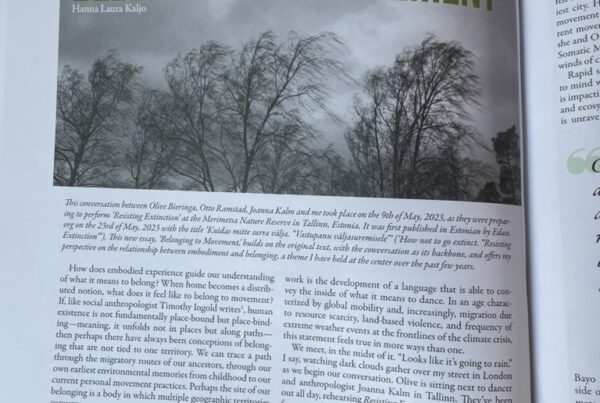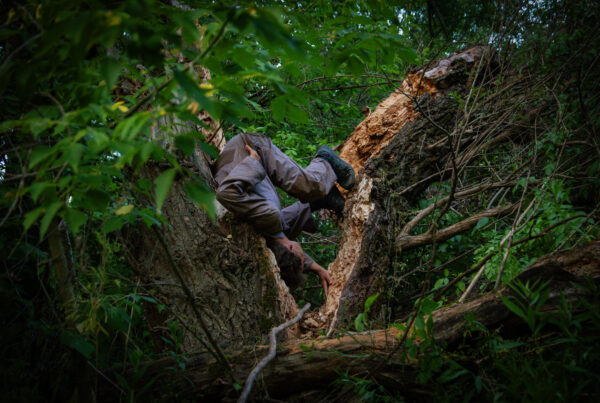Author: Sue Cheesman
Source: DANZ Quarterly
Date: 2007
Olive Bieringa, a first generation New Zealander, and Otto Ramstad, a third generation American, travel the globe by desire and necessity in order to connect with land, family, explore new cultural contexts and sustain their work practices in dance. These two co-directors, dance performers and video artists regularly return to New Zealand, this time primarily, to run a weeklong BodyCartography project, and to teach the first Body-Mind Centering© (BMC) workshop in NZ.
These two co-directors, dance performers and video artists regularly return to New Zealand, this time primarily, to run a weeklong BodyCartography project, and to teach the first Body-Mind Centering© (BMC) workshop in NZ.
Olive founded The BodyCartography Project – making art in the environment – in 1997. “I had the idea of using different somatic practices to make dancing happen in public space”. These somatic movement practices include contact improvisation, Body-Mind Centering, Lisa Nelson Tunning Score, release technique, butoh, capoeira and improvisational composition. She wanted to share these embodied dance practices with the world and audiences beyond flat floors, mirrored studio walls and the theatre.
Olive says “we investigate and create with the bodies’ relationships to the physical, architectural, climatic, technological and social landscapes that we inhabit in urban/wilderness and private/public contexts”.
The BodyCartography project covers a wide range of situations and movement material, both physical and pedestrian. Olive gives examples: “It could be an ensemble of people in a unified colour doing pedestrian walking in slow motion for an hour down the street or people being in their energetic animal sensorial perspective moving through a crowded city street dressed in suits, or a group of people on the side of a hill flying, falling and tumbling, or fifteen people upside down in a boat, legs extending and moving in unison”.
Olive and Otto have been dancing in public spaces, sharing their embodied dance practices with the world outside of the theatre, for over eight years. Olive says “It is important to present work that people can engage with, that is step up in some way to find meaning for themselves as opposed to offering a whole narrative”. The viewer brings their own reading to the work, allowing for a multiplicity of viewpoints.
Otto adds “we are also interested in noticing the physicality and behaviours we exhibit generally in day to day existence which are limited. We are interested in a personal liberation, expanding what you do in a public situation – a super-human pedestrian person.”
Olive says “Some of our work is very performance orientated, generating a conventional show with a beginning, middle and end. The audience sits in a given place. We have a very specific sense of framing that is where we want the audience to see the work from. Other times it is what I would call an event, like a procession or happening. For example in the context of a peace demonstration, we stay with the rally doing a specific activity.”
Underpinning most of their work is Body Mind Centering (BMC), which Otto describes as an approach to understanding the body as opposed to imposing a series of exercises around a style, shape or a form. “It is not a specific way of moving, it gives you the tools to be able to make different kinds of choices, opening up possibilities for different ways of moving.”
I have had the book of Bonnie Bainbridge Cohen (USA), founder of BMC, on my book self since 1995 and I was excited to engage with this approach in physical terms.
In the workshop I attended we were introduced to particular systems; for example fluids /blood, breathing or nervous systems with detailed anatomy pictures to support our understandings. In pairs, using a hands-on task,we experienced a series of progressions which developed into an improvisational dance around what we were noticing in relation to the particular system in focus. The workshop was very experiential and we continually shifted between observing and embodying.
In leading the BMC workshop, Otto seems to come from a very intuitive place in this work probably born out of the fact that he was exposed to BMC at an early age, although he did not remember it cognitively. Two blocks from his house in an after school programme from the age of six to fourteen, he took a dance class which included creative movement and BMC from a BMC trained teacher. In their workshop I found both Otto and Olive to be articulate and competent teachers with very inclusive pedagogy.
Olive says “Stuff that we teach is foundational to what we use to make performance. One thing we will often teach is working with senses and perceptions which is totally essential and is about information coming in and motoring out. How are we collecting information from the world we live in? How do we take self responsibility to create a different social structure? It is about the quality of life and generating a different value system”.
In addition to their joint work both have solo practices. Olive says “my solo work is the only time when I get to work in non-compromised space as opposed to working in collaboration or with different kinds of movers. Both of us can ask the questions we are particularly interested in”.
They have a substantial body of work which includes eight short films, one hundred and thirty performance events and solo practices between them. Otto would like a larger selection of clothes to wear in nine months other than the ones that fit in his global travel bag. Not to mention the exhaustion factor in moving around a lot and the necessity to be very flexible. Olive says “as one gets older, how do you rectify that situation and how do you create more stability and where do you need to be to do that, is an enormous question we are grappling with all the time”. However their nomadic life style continues with their new collaborative project between NZ, Japan and the US, about how technology is changing our understanding of intimacy, beginning later this year.


